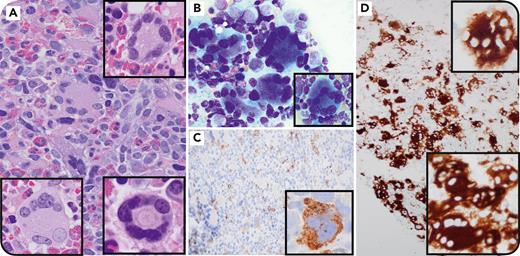A 60-year-old woman presented with anemia (hemoglobin, 8.7 g/dL), leukopenia (2.9 × 109/L), and mild thrombocytopenia (135 × 109/L). Bone marrow examination revealed 9% blasts, eosinophilia, and multilineage dysplasia, particularly conspicuous in the megakaryocytic lineage. Megakaryocytes exhibited hyperchromatic nuclei, often with widely separated lobes demonstrating a distinct “ring-form” morphology (panel A: hematoxylin and eosin stain, 100× objective). Similar features are noted on the marrow aspirate (panel B: May-Grünwald-Giemsa stain, 100× objective; inset: 100× objective). CD34 immunohistochemistry highlighted mildly increased blasts and aberrant expression in megakaryocytes (panel C: immunohistochemical stain, 40× objective; inset: 100× objective). CD61 immunohistochemistry confirmed megakaryocytic clustering and ring-form morphology (panel D: immunohistochemical stain, 40× objective; inset: 100× objective). Chromosome analysis displayed gain of chromosome 8 in all 20 metaphase cells. Molecular studies identified 3 pathogenic variants in STAG2: 2 truncating oncogenic mutations (R614∗, variant allele frequency [VAF] 12% and R305∗, VAF 29%) and a missense mutation (P985T, VAF 38%). Germ line analysis was negative for mutations. A diagnosis of myelodysplastic neoplasm (syndrome) with increased (excess) blasts was rendered.
Megakaryocytic dysplasia has been previously described in patients with STAG2 mutation. Our case further illustrates an unusual ring-form type of megakaryocytic dysplasia seen in the presence of multiple STAG2-pathogenic variants.
For additional images, visit the ASH Image Bank, a reference and teaching tool that is continually updated with new atlas and case study images. For more information, visit https://imagebank.hematology.org.


This feature is available to Subscribers Only
Sign In or Create an Account Close Modal